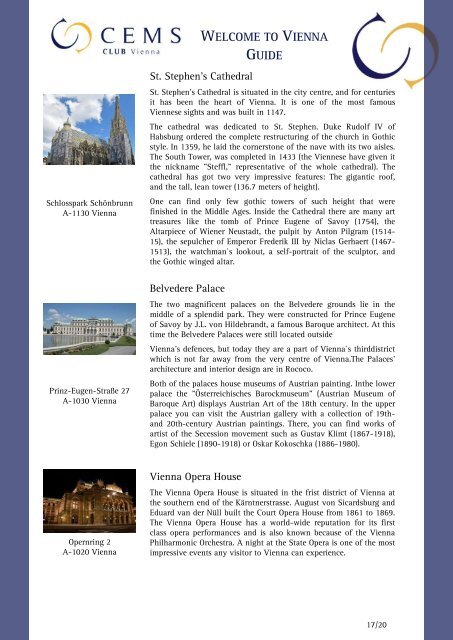Create successful ePaper yourself
Turn your PDF publications into a flip-book with our unique Google optimized e-Paper software.
WELCOME TO VIENNA<br />
GUIDE<br />
Schlosspark Schönbrunn<br />
A-1130 <strong>Vienna</strong><br />
Prinz-Eugen-Straße 27<br />
A-1030 <strong>Vienna</strong><br />
St. Stephen’s C<strong>at</strong>hedral<br />
St. Stephen's C<strong>at</strong>hedral is situ<strong>at</strong>ed in the city centre, and for centuries<br />
it has been the heart of <strong>Vienna</strong>. It is one of the most famous<br />
Viennese sights and was built in 1147.<br />
The c<strong>at</strong>hedral was dedic<strong>at</strong>ed <strong>to</strong> St. Stephen. Duke Rudolf IV of<br />
Habsburg ordered the complete restructuring of the church in Gothic<br />
style. In 1359, he laid the corners<strong>to</strong>ne of the nave with its two aisles.<br />
The South Tower, was completed in 1433 (the Viennese have given it<br />
the nickname "Steffl," represent<strong>at</strong>ive of the whole c<strong>at</strong>hedral). The<br />
c<strong>at</strong>hedral has got two very impressive fe<strong>at</strong>ures: The gigantic roof,<br />
and the tall, lean <strong>to</strong>wer (136.7 meters of height).<br />
One can find only few gothic <strong>to</strong>wers of such height th<strong>at</strong> were<br />
finished in the Middle Ages. Inside the C<strong>at</strong>hedral there are many art<br />
treasures like the <strong>to</strong>mb of Prince Eugene of Savoy (1754), the<br />
Altarpiece of Wiener Neustadt, the pulpit by An<strong>to</strong>n Pilgram (1514-<br />
15), the sepulcher of Emperor Frederik III by Niclas Gerhaert (1467-<br />
1513), the w<strong>at</strong>chman`s lookout, a self-portrait of the sculp<strong>to</strong>r, and<br />
the Gothic winged altar.<br />
Belvedere Palace<br />
The two magnificent palaces on the Belvedere grounds lie in the<br />
middle of a splendid park. They were constructed for Prince Eugene<br />
of Savoy by J.L. von Hildebrandt, a famous Baroque architect. At this<br />
time the Belvedere Palaces were still loc<strong>at</strong>ed outside<br />
<strong>Vienna</strong>'s defences, but <strong>to</strong>day they are a part of <strong>Vienna</strong>`s thirddistrict<br />
which is not far away from the very centre of <strong>Vienna</strong>.The Palaces'<br />
architecture and interior design are in Rococo.<br />
Both of the palaces house museums of Austrian painting. Inthe lower<br />
palace the "Österreichisches Barockmuseum" (Austrian Museum of<br />
Baroque Art) displays Austrian Art of the 18th century. In the upper<br />
palace you can visit the Austrian gallery with a collection of 19thand<br />
20th-century Austrian paintings. There, you can find works of<br />
artist of the Secession movement such as Gustav Klimt (1867-1918),<br />
Egon Schiele (1890-1918) or Oskar Kokoschka (1886-1980).<br />
Opernring 2<br />
A-1020 <strong>Vienna</strong><br />
<strong>Vienna</strong> Opera House<br />
The <strong>Vienna</strong> Opera House is situ<strong>at</strong>ed in the frist district of <strong>Vienna</strong> <strong>at</strong><br />
the southern end of the Kärntnerstrasse. August von Sicardsburg and<br />
Eduard van der Nüll built the Court Opera House from 1861 <strong>to</strong> 1869.<br />
The <strong>Vienna</strong> Opera House has a world-wide reput<strong>at</strong>ion for its first<br />
class opera performances and is also known because of the <strong>Vienna</strong><br />
Philharmonic Orchestra. A night <strong>at</strong> the St<strong>at</strong>e Opera is one of the most<br />
impressive events any visi<strong>to</strong>r <strong>to</strong> <strong>Vienna</strong> can experience.<br />
17/20


